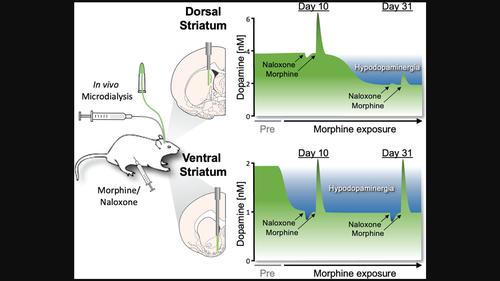当前位置:
X-MOL 学术
›
Eur. J. Neurosci.
›
论文详情
Our official English website, www.x-mol.net, welcomes your feedback! (Note: you will need to create a separate account there.)
Differential patterns of basal and naloxone-evoked dopamine efflux in the rat dorsal and ventral striatum following prolonged-intermittent exposure to morphine
European Journal of Neuroscience ( IF 3.698 ) Pub Date : 2023-11-20 , DOI: 10.1111/ejn.16192 Soyon Ahn 1 , Haiyan Zou 1 , Jeremy K. Seamans 1 , Anthony G. Phillips 1
European Journal of Neuroscience ( IF 3.698 ) Pub Date : 2023-11-20 , DOI: 10.1111/ejn.16192 Soyon Ahn 1 , Haiyan Zou 1 , Jeremy K. Seamans 1 , Anthony G. Phillips 1
Affiliation

|
Hypodopaminergia in the ventral striatum is a putative neurobiological correlate of withdrawal in opioid-dependent individuals. This perspective stands in contrast to brain imaging studies with chronic opioid users showing that naloxone-enhanced dopamine (DA) release in the dorsal striatum is positively correlated with withdrawal aversion. Here, we examined regional differences in striatal DA function associated with opioid withdrawal in rats exposed to intermittent morphine injections for 31 days. Basal concentrations of DA were reduced (i.e., indicating a hypodopaminergic state) in the ventral striatum on Day 10 of morphine exposure, whereas a more prolonged period of morphine treatment was required to reveal hypodopaminergia in the dorsal striatum on Day 31. The ventral striatum consistently exhibited naloxone-induced transient reductions in DA below the hypodopaminergic basal levels, whereas morphine enhanced DA efflux. In the dorsal striatum, DA responsivity to naloxone shifted from a significant decrease on Day 10 to a notable increase above hypodopaminergic basal levels on Day 31, corroborating the findings in the human dorsal striatum. Unexpectedly, the magnitude of morphine-evoked increases in DA efflux on Day 31 was significantly blunted relative to values on Day 10. These findings indicate that prolonged-intermittent access to morphine results in a sustained hypodopaminergic state as reflected in basal levels in the striatum, which is accompanied by regional differences in DA responsivity to naloxone and morphine. Overall, our findings suggest that prolonging the duration of morphine exposure to 31 days is sufficient to reveal neuroadaptations that may underlie the transition from initial drug exposure to opioid dependence.
中文翻译:

长期间歇性接触吗啡后大鼠背侧和腹侧纹状体基础和纳洛酮诱发的多巴胺流出的差异模式
腹侧纹状体的多巴胺能减退是阿片类药物依赖个体戒断的假定神经生物学相关性。这一观点与长期阿片类药物使用者的脑成像研究形成鲜明对比,研究表明纳洛酮增强的背侧纹状体多巴胺(DA)释放与戒断厌恶呈正相关。在这里,我们检查了间歇注射吗啡 31 天的大鼠中与阿片类药物戒断相关的纹状体 DA 功能的区域差异。吗啡暴露第 10 天,腹侧纹状体的 DA 基础浓度降低(即表明多巴胺能低下状态),而第 31 天需要更长时间的吗啡治疗才能显示背侧纹状体多巴胺能低下。腹侧纹状体始终如一表现出纳洛酮诱导的 DA 短暂减少至低多巴胺能基础水平以下,而吗啡则增强 DA 流出。在背侧纹状体中,DA 对纳洛酮的反应性从第 10 天的显着下降转变为第 31 天的显着增加,高于低多巴胺能基础水平,证实了人类背侧纹状体的发现。出乎意料的是,第 31 天吗啡引起的 DA 流出量增加的幅度相对于第 10 天的值显着减弱。这些发现表明,长时间间歇性获取吗啡会导致持续的低多巴胺能状态,这反映在纹状体的基础水平上。 DA 对纳洛酮和吗啡的反应性存在区域差异。总体而言,我们的研究结果表明,将吗啡暴露持续时间延长至 31 天足以揭示神经适应,这可能是从最初药物暴露到阿片类药物依赖转变的基础。
更新日期:2023-11-20
中文翻译:

长期间歇性接触吗啡后大鼠背侧和腹侧纹状体基础和纳洛酮诱发的多巴胺流出的差异模式
腹侧纹状体的多巴胺能减退是阿片类药物依赖个体戒断的假定神经生物学相关性。这一观点与长期阿片类药物使用者的脑成像研究形成鲜明对比,研究表明纳洛酮增强的背侧纹状体多巴胺(DA)释放与戒断厌恶呈正相关。在这里,我们检查了间歇注射吗啡 31 天的大鼠中与阿片类药物戒断相关的纹状体 DA 功能的区域差异。吗啡暴露第 10 天,腹侧纹状体的 DA 基础浓度降低(即表明多巴胺能低下状态),而第 31 天需要更长时间的吗啡治疗才能显示背侧纹状体多巴胺能低下。腹侧纹状体始终如一表现出纳洛酮诱导的 DA 短暂减少至低多巴胺能基础水平以下,而吗啡则增强 DA 流出。在背侧纹状体中,DA 对纳洛酮的反应性从第 10 天的显着下降转变为第 31 天的显着增加,高于低多巴胺能基础水平,证实了人类背侧纹状体的发现。出乎意料的是,第 31 天吗啡引起的 DA 流出量增加的幅度相对于第 10 天的值显着减弱。这些发现表明,长时间间歇性获取吗啡会导致持续的低多巴胺能状态,这反映在纹状体的基础水平上。 DA 对纳洛酮和吗啡的反应性存在区域差异。总体而言,我们的研究结果表明,将吗啡暴露持续时间延长至 31 天足以揭示神经适应,这可能是从最初药物暴露到阿片类药物依赖转变的基础。



























 京公网安备 11010802027423号
京公网安备 11010802027423号